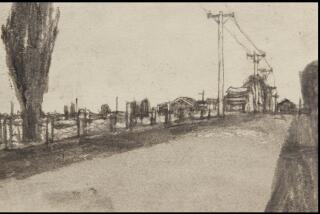Tagging, that primal instinct
- Share via
DUDE, where’s my mammoth?
R. Dale Guthrie, professor emeritus in the Institute of Arctic Biology at the University of Alaska Fairbanks, has turned to crudely drawn images of such prehistoric beasts as the woolly mammoth, the giant bison and the auroch (an extinct bovine species) to support his theory that -- as is the case with today’s graffiti -- testosterone-fueled boys produced virtually all cave art.
In a new book, “The Nature of Paleolithic Art,” the professor suggests that the often bloody images of animals fleeing or dying during the hunt drawn on cave walls between 10,000 and 40,000 years ago during the Pleistocene Epoch in many ways compare to the hot cars, spaceships and action figures that often turn up in the doodlings of today’s early teenage males.
Guthrie also writes that another frequent image -- curvaceous females -- suggests that, even 40,000 years ago, young guys would not have been buying Playboy for the articles.
“The main images are large mammals -- no butterflies, no babies, no insects, no small animals, no women with clothes on,” Guthrie said in an interview last week. “Women tend to be plump above and below the waist, and men are all lean.” Guthrie also noted that the male genitalia are rendered with much less detail and enthusiasm than those of the women. “Who cares about other guys?” he reasoned.
Guthrie, who is also an artist, said his decades of study of Paleolithic mammals led him to cave paintings in the first place. In the caverns he studied were remarkably small handprints -- too small to be those of adult males. And in most cases, the handprints, hand lengths, palm widths, and finger widths and lengths mostly matched hands that would have belonged to boys ages 9 to 17, although a few female prints suggested there were groupies in the Pleistocene.
Most important for Guthrie, the theory that most of the paintings were created by a bunch of prehistoric taggers flies in the face of the common notion that cave paintings are religious iconography and were created by adults.
“There is this strange idea that these were shamans, wandering around in some mystical state,” he said.
*
Diane Haithman
More to Read
Sign up for Essential California
The most important California stories and recommendations in your inbox every morning.
You may occasionally receive promotional content from the Los Angeles Times.












